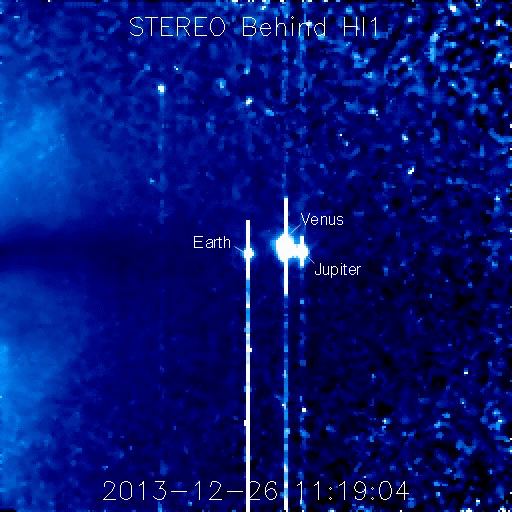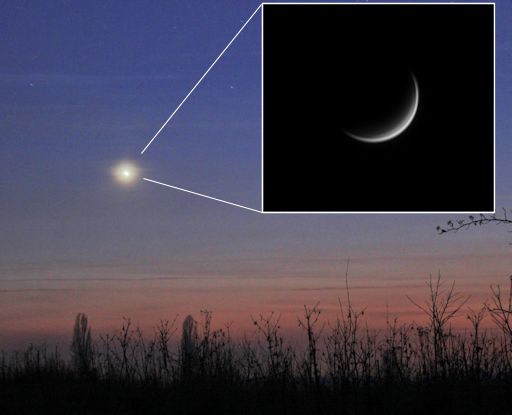SLIGHT CHANCE OF FLARES: Sunspot AR1934 has a 'beta-gamma' magnetic field that harbors energy for M-class solar flares. Because the region is directly facing Earth, any flares today would surely be geoeffective. The sunspot has been relatively quiet for days, however, so NOAA forecasters are estimating only a 25% chance of M-flares. Solar flare alerts: text, voice.
CHRISTMAS CONJUNCTION CONTINUES: Christmas is over, but the amazing "Christmas conjunction" is still underway. As seen from NASA's STEREO-B spacecraft, the three planets Venus, Earth and Jupiter are clustered in a circle barely 2 degrees wide. The spacecraft's Heliospheric Imager took this picture on Dec. 26th:
Because of the holidays, this conjunction in space raises comparisons to a famous Christmas conjunction on Earth. According to some scholars, the Star of Bethlehem might have been a close encounter between Venus and Jupiter. The two brightest planets in the night sky, merged, would have made a spectacle so amazing that we still talk about it ~2000 years later.
Unlike conjunctions of the distant past, this one includes our home planet. STEREO-B is located on the far side of the sun where it can look back and see Earth along with other worlds in the Solar System. From STEREO-B's point of view, Jupiter and Venus about 0.5 degrees apart. That is not nearly as tight as the putative Star of Bethlehem conjunction when those two planets were separated by as little as 6 arcseconds (0.00166 degrees). Nevertheless, the Christmas conjunction of 2013 is special because it includes Earth--the first time in history such a conjunction is possible. Happy holidays from STEREO!
Realtime Space Weather Photo Gallery
CHRISTMAS LIGHTS: Skies above the Arctic Circle turned green on Dec. 25th when the interplanetary magnetic (IMF) field near Earth turned south. This opened a crack in our planet's magnetosphere. Solar wind poured in and fueled a display of Northern Lights:
:"I saw these at 8:30 am on Dec. 25th," says photographer John Dean of Nome, Alaska. "They were the first Christmas auroras I have ever seen."
The day after Christmas could be good, too. A solar wind stream is expected to brush past Earth's magnetic field on Dec. 26th, prompting NOAA to estimate a 35% chance of polar geomagnetic storms. High-latitude sky watchers should remain alert for auroras. Aurora alerts: text, voice.
CRESCENT VENUS: Wondering where to point that telescope you got for Christmas? Here's a target that will blow your holiday socks off: Venus. Like the Moon, Venus has phases, and at the moment it is a slender crescent. Maximilian Teodorescu sends this Christmas Eve photo from Targoviste, Romania:
"I enjoyed another superb sunset with Venus dominating the southwestern sky," says Teodorescu. "The bright planet was visible even through cirrus clouds. Despite poor seeing conditions, the view through my refracting telescope was superb both at 30x and at 200x."
Every night the crescent grows thinner as Venus moves toward inferior conjunction with the sun in early January. Tonight, only 10% of the planet's illuminated hemisphere is visible from Earth. Because Venus is so thin, refraction in our atmosphere can produce a rainbow effect as colorful as any Christmas ornament. It really is a magical sight. More information is available from Sky and Telescope.

Solar wind
speed: 257.2 km/sec
density: 1.5 protons/cm3
explanation | more data
Updated: Today at 2027 UT
X-ray Solar Flares
6-hr max: B6 1538 UT Dec26
24-hr: C2 0702 UT Dec26
explanation | more data
Updated: Today at: 1959 UT
![]()
Daily Sun: 26 Dec 13
Sunspot AR1934 has a 'beta-gamma' magnetic field that harbors energy for M-class solar flares. Credit: SDO/HMI
![]()
Sunspot number: 81
What is the sunspot number?
Updated 26 Dec 2013
Spotless Days
Current Stretch: 0 days
2013 total: 0 days (0%)
2012 total: 0 days (0%)
2011 total: 2 days (<1%)
2010 total: 51 days (14%)
2009 total: 260 days (71%)
Since 2004: 821 days
Typical Solar Min: 486 days
Update 26 Dec 2013
The Radio Sun
10.7 cm flux: 123 sfu
explanation | more data
Updated 26 Dec 2013
![]()
Current Auroral Oval:
Switch to: Europe, USA, New Zealand, Antarctica
Credit: NOAA/POES
![]()
Planetary K-index
Now: Kp= 0 quiet
24-hr max: Kp= 1 quiet
explanation | more data
Interplanetary Mag. Field
Btotal: 4.5 nT
Bz: 4.2 nT north
explanation | more data
Updated: Today at 2027 UT
![]()
Coronal Holes: 26 Dec 13
Solar wind flowing from the indicated coronal hole could reach Earth on Dec. 26. Credit: SDO/AIA.







